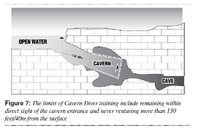For me, I let common sense rule my decisions when I started to penetrate wrecks. If I was on the outside of a wreck and could easily see my way through I had no problem going in and swimming through. Also, most of the time you're going to be on a boat with a dive operation when you go. I know when we have visited the Tibbets wreck on Cayman Brac, the DM will give a briefing on the wreck and will identify certain areas of the wreck that have wide openings and would make a good place to enter and look around and they offer to lead you through such areas if you would like for them to.
I'd say use the same criteria, good judgement and the dive briefing, to decide if you want to do a swim through or not.
Yep. For many and perhaps most people, common sense is all it takes, and if you took the course, you might well argue that a lot of it is common sense. For example, if you can see that entire inside of a wreck with multiple entrances and exits, that would be a criterion for deciding it might be something you can handle. The familiarity issue Bob mentions would also be a factor. If you have dived the Tracy off Fort Lauderdale 10 times and know there is nothing in the main deck deck area but schools of fish, you will probably feel just fine about entering it again.
But not all people are blessed with common sense, and not all people are concerned enough about familiarity. For example, a couple of years ago someone argued on ScubaBoard that he could swim from the Devil's Eye spring to the Devil's Ear spring at Ginnie Springs in Florida. They are two entrances to the same cave and not very far apart, so it would be just like the swim throughs he had done so many times before. All you have to do do is keep left to keep heading to the Ear opening. Common sense, right? Of course, he could not tell that it only looked that way on the surface. The way the tunnel from the Eye turns means that the opening to the Ear is behind you and to the right as you swim--almost unnoticeable. Keeping left takes you into the Catacombs, a silty labyrinth of tunnels. It is believed that an open water diver found in the Catacombs a couple of years ago got there because he, too, was fooled by the apparent swim through situation, but he was in no condition when he was found to explain his reasoning.
The course content includes that example in great detail, BTW. The picture used was supplied with permission by a key member of one of the cave diving agencies in the hope the course would help keep untrained people out of caves.




